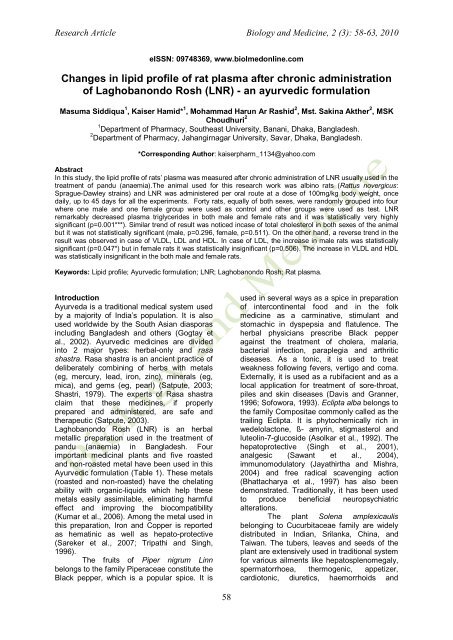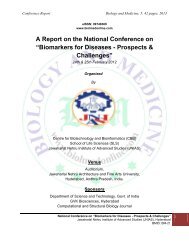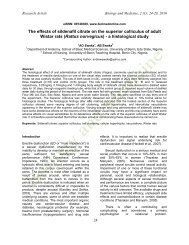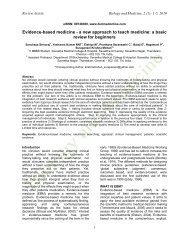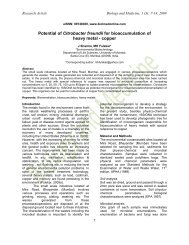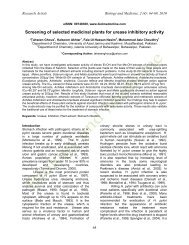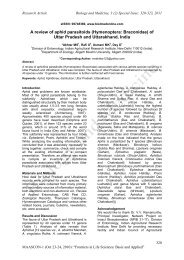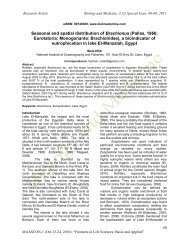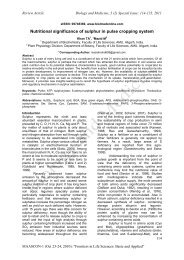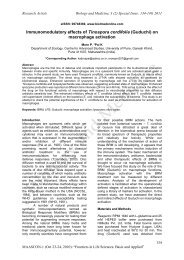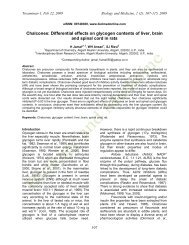Changes in lipid profile of rat plasma after chronic administration of ...
Changes in lipid profile of rat plasma after chronic administration of ...
Changes in lipid profile of rat plasma after chronic administration of ...
- No tags were found...
You also want an ePaper? Increase the reach of your titles
YUMPU automatically turns print PDFs into web optimized ePapers that Google loves.
Research Article Biology and Medic<strong>in</strong>e, 2 (3): 58-63, 2010eISSN: 09748369, www.biolmedonl<strong>in</strong>e.com<strong>Changes</strong> <strong>in</strong> <strong>lipid</strong> <strong>pr<strong>of</strong>ile</strong> <strong>of</strong> <strong>rat</strong> <strong>plasma</strong> <strong>after</strong> <strong>chronic</strong> adm<strong>in</strong>ist<strong>rat</strong>ion<strong>of</strong> Laghobanondo Rosh (LNR) - an ayurvedic formulationMasuma Siddiqua 1 , Kaiser Hamid* 1 , Mohammad Harun Ar Rashid 2 , Mst. Sak<strong>in</strong>a Akther 2 , MSKChoudhuri 21 Department <strong>of</strong> Pharmacy, Southeast University, Banani, Dhaka, Bangladesh.2 Department <strong>of</strong> Pharmacy, Jahangirnagar University, Savar, Dhaka, Bangladesh.*Correspond<strong>in</strong>g Author: kaiserpharm_1134@yahoo.comAbstractIn this study, the <strong>lipid</strong> <strong>pr<strong>of</strong>ile</strong> <strong>of</strong> <strong>rat</strong>s’ <strong>plasma</strong> was measured <strong>after</strong> <strong>chronic</strong> adm<strong>in</strong>ist<strong>rat</strong>ion <strong>of</strong> LNR usually used <strong>in</strong> thetreatment <strong>of</strong> pandu (anaemia).The animal used for this research work was alb<strong>in</strong>o <strong>rat</strong>s (Rattus novergicus:Sprague-Dawley stra<strong>in</strong>s) and LNR was adm<strong>in</strong>istered per oral route at a dose <strong>of</strong> 100mg/kg body weight, oncedaily, up to 45 days for all the experiments. Forty <strong>rat</strong>s, equally <strong>of</strong> both sexes, were randomly grouped <strong>in</strong>to fourwhere one male and one female group were used as control and other groups were used as test. LNRremarkably decreased <strong>plasma</strong> triglycerides <strong>in</strong> both male and female <strong>rat</strong>s and it was statistically very highlysignificant (p=0.001***). Similar trend <strong>of</strong> result was noticed <strong>in</strong>case <strong>of</strong> total cholesterol <strong>in</strong> both sexes <strong>of</strong> the animalbut it was not statistically significant (male, p=0.296, female, p=0.511). On the other hand, a reverse trend <strong>in</strong> theresult was observed <strong>in</strong> case <strong>of</strong> VLDL, LDL and HDL. In case <strong>of</strong> LDL, the <strong>in</strong>crease <strong>in</strong> male <strong>rat</strong>s was statisticallysignificant (p=0.047*) but <strong>in</strong> female <strong>rat</strong>s it was statistically <strong>in</strong>significant (p=0.506). The <strong>in</strong>crease <strong>in</strong> VLDL and HDLwas statistically <strong>in</strong>significant <strong>in</strong> the both male and female <strong>rat</strong>s.Keywords: Lipid <strong>pr<strong>of</strong>ile</strong>; Ayurvedic formulation; LNR; Laghobanondo Rosh; Rat <strong>plasma</strong>.IntroductionAyurveda is a traditional medical system usedby a majority <strong>of</strong> India’s population. It is alsoused worldwide by the South Asian diasporas<strong>in</strong>clud<strong>in</strong>g Bangladesh and others (Gogtay etal., 2002). Ayurvedic medic<strong>in</strong>es are divided<strong>in</strong>to 2 major types: herbal-only and rasashastra. Rasa shastra is an ancient practice <strong>of</strong>delibe<strong>rat</strong>ely comb<strong>in</strong><strong>in</strong>g <strong>of</strong> herbs with metals(eg, mercury, lead, iron, z<strong>in</strong>c), m<strong>in</strong>erals (eg,mica), and gems (eg, pearl) (Satpute, 2003;Shastri, 1979). The experts <strong>of</strong> Rasa shastraclaim that these medic<strong>in</strong>es, if properlyprepared and adm<strong>in</strong>istered, are safe andtherapeutic (Satpute, 2003).Laghobanondo Rosh (LNR) is an herbalmetallic prepa<strong>rat</strong>ion used <strong>in</strong> the treatment <strong>of</strong>pandu (anaemia) <strong>in</strong> Bangladesh. Fourimportant medic<strong>in</strong>al plants and five roastedand non-roasted metal have been used <strong>in</strong> thisAyurvedic formulation (Table 1). These metals(roasted and non-roasted) have the chelat<strong>in</strong>gability with organic-liquids which help thesemetals easily assimilable, elim<strong>in</strong>at<strong>in</strong>g harmfuleffect and improv<strong>in</strong>g the biocompatibility(Kumar et al., 2006). Among the metal used <strong>in</strong>this prepa<strong>rat</strong>ion, Iron and Copper is reportedas hemat<strong>in</strong>ic as well as hepato-protective(Sareker et al., 2007; Tripathi and S<strong>in</strong>gh,1996).The fruits <strong>of</strong> Piper nigrum L<strong>in</strong>nbelongs to the family Piperaceae constitute theBlack pepper, which is a popular spice. It isused <strong>in</strong> several ways as a spice <strong>in</strong> prepa<strong>rat</strong>ion<strong>of</strong> <strong>in</strong>tercont<strong>in</strong>ental food and <strong>in</strong> the folkmedic<strong>in</strong>e as a carm<strong>in</strong>ative, stimulant andstomachic <strong>in</strong> dyspepsia and flatulence. Theherbal physicians prescribe Black pepperaga<strong>in</strong>st the treatment <strong>of</strong> cholera, malaria,bacterial <strong>in</strong>fection, paraplegia and arthriticdiseases. As a tonic, it is used to treatweakness follow<strong>in</strong>g fevers, vertigo and coma.Externally, it is used as a rubifacient and as alocal application for treatment <strong>of</strong> sore-throat,piles and sk<strong>in</strong> diseases (Davis and Granner,1996; S<strong>of</strong>owora, 1993). Eclipta alba belongs tothe family Compositae commonly called as thetrail<strong>in</strong>g Eclipta. It is phytochemically rich <strong>in</strong>wedelolactone, ß- amyr<strong>in</strong>, stigmasterol andluteol<strong>in</strong>-7-glucoside (Asolkar et al., 1992). Thehepatoprotective (S<strong>in</strong>gh et al., 2001),analgesic (Sawant et al., 2004),immunomodulatory (Jayathirtha and Mishra,2004) and free radical scaveng<strong>in</strong>g action(Bhattacharya et al., 1997) has also beendemonst<strong>rat</strong>ed. Traditionally, it has been usedto produce beneficial neuropsychiatricalte<strong>rat</strong>ions.The plant Solena amplexicaulisbelong<strong>in</strong>g to Cucurbitaceae family are widelydistributed <strong>in</strong> Indian, Srilanka, Ch<strong>in</strong>a, andTaiwan. The tubers, leaves and seeds <strong>of</strong> theplant are extensively used <strong>in</strong> traditional systemfor various ailments like hepatosplenomegaly,spermatorrhoea, thermogenic, appetizer,cardiotonic, diuretics, haemorrhoids and58
Research Article Biology and Medic<strong>in</strong>e, 2 (3): 58-63, 2010Statistical AnalysisThe group data was expressed as Mean ±SEM (Standard Error <strong>of</strong> the Mean). Unpaired"t" tests were done for statistical significancetests. SPSS (Statistical Package for SocialScience) for WINDOWS (Ver. 11) was appliedfor the analysis <strong>of</strong> data. Differences betweengroups were considered significant at p < 0.05,0.01 and 0.001.ResultsSimilar trend <strong>of</strong> changes <strong>in</strong> the <strong>lipid</strong> <strong>pr<strong>of</strong>ile</strong>parameters were observed <strong>in</strong> both male andfemale <strong>rat</strong>s dur<strong>in</strong>g the course <strong>of</strong> research. Thedecrement <strong>of</strong> <strong>plasma</strong> triglycerides <strong>in</strong> bothsexes <strong>of</strong> animals was noteworthy and it wasstatistically very highly significant (p=0.001***).In case <strong>of</strong> total cholesterol, a decreas<strong>in</strong>g trendwas observed <strong>in</strong> both male (p=0.296) andfemale <strong>rat</strong>s (p=0.511). On the contrary theconcent<strong>rat</strong>ion <strong>of</strong> VLDL, LDL and HDLcholesterol was <strong>in</strong>creased <strong>in</strong> both male andfemale <strong>rat</strong>s and the <strong>in</strong>crease <strong>of</strong> LDL <strong>in</strong> male<strong>rat</strong>s was statistically significant (p=0.047*).The <strong>in</strong>crease <strong>in</strong> VLDL and HDL <strong>in</strong> both maleand female <strong>rat</strong>s was not statistically significant(Table 2, Graph 1 and 2).DiscussionAtherogenicity with subsequent cardiovascularmanifestations is one <strong>of</strong> the major causes <strong>of</strong>death and morbidity <strong>in</strong> the world (Raju andB<strong>in</strong>da, 2005). Various studies <strong>in</strong>dicate thathigh serum cholesterol levels are stronglyrelated to coronary atherosclerosis and<strong>in</strong>creased risk <strong>of</strong> cardiovascular diseases.Cl<strong>in</strong>ical studies have also shown that lower<strong>in</strong>glevels <strong>of</strong> serum cholesterol us<strong>in</strong>g diet or drugsdecreases the <strong>in</strong>cidence <strong>of</strong> coronary heartdisease (Ste<strong>in</strong>er and Li, 2000; Treasure et al.,1995). The levels <strong>of</strong> serum TC and TG werefound to be significantly reduced <strong>in</strong> the LNRtreated animals. This might be due to thereduced hepatic triglyceride synthesis and orreduced lipolysis that might be due to the<strong>in</strong>crease <strong>in</strong> serum <strong>in</strong>sul<strong>in</strong> levels <strong>in</strong> the LNRtreated <strong>rat</strong>s. (Sivaraj et al., 2009). Theobserved hypotriglyceridemic effect may bedue to a decrease <strong>of</strong> fatty acids synthesis(Bopanna et al., 1997), enhanced catabolism<strong>of</strong> LDL, activation <strong>of</strong> LCAT and tissues lipases(Khanna et al., 2002) and/or <strong>in</strong>hibition <strong>of</strong>acetyl-CoA carboxylase (McCarty, 2001) andproduction <strong>of</strong> triglycerides precursors suchacetyl-CoA and glycerol phosphate.The underly<strong>in</strong>g mechanism by whichLNR exerts its cholesterol lower<strong>in</strong>g effectseems to be a decrease <strong>in</strong> cholesterolabsorption from the <strong>in</strong>test<strong>in</strong>e, by b<strong>in</strong>d<strong>in</strong>g withbile acids with<strong>in</strong> the <strong>in</strong>test<strong>in</strong>e and <strong>in</strong>creas<strong>in</strong>gbile acids excretion (Kritchevsky, 1978; Kellyand Tsai, 1978). LNR can also act bydecreas<strong>in</strong>g the cholesterol biosynthesisespecially by decreas<strong>in</strong>g the 3-hydroxy-3-methyl-glutaryl coenzyme A reductase(HMGCoA reductase) activity, a key enzyme<strong>of</strong> cholesterol biosynthesis (Kedar andChakrabarti, 1982; Sharma et al., 2003) and/orby reduc<strong>in</strong>g the NADPH required for fattyacids and cholesterol synthesis (Chi, 1982).HDL cholesterol is an <strong>in</strong>dependent negativerisk factor for coronary artery disease, atpresent represent<strong>in</strong>g the only protective factoraga<strong>in</strong>st atherosclerosis. The HDL <strong>in</strong>creas<strong>in</strong>geffect <strong>of</strong> LNR is largely attributed to its centralfunction <strong>in</strong> the reverse cholesterol transport, aprocess whereby excess cell cholesterol istaken up and processed by HDL particles forfurther delivery to the liver for metabolism(Mart<strong>in</strong>ez et al., 2004).ConclusionLNR is a popular Ayurvedic formulation used<strong>in</strong> the treatment <strong>of</strong> pandu (anemia) <strong>in</strong>Bangladesh. In the present study, the changescaused by LNR was not congruent <strong>in</strong>case <strong>of</strong>all the studied parameters <strong>of</strong> <strong>lipid</strong> <strong>pr<strong>of</strong>ile</strong>particularly <strong>in</strong>case <strong>of</strong> LDL and VLDL. So itnecessitates further <strong>in</strong>vestigation for us<strong>in</strong>gLNR <strong>in</strong> the patients who are at risk <strong>in</strong> thedevelopment <strong>of</strong> cardiovascular disease.ReferencesAsolkar AV, Kakkar KK, Chakre OJ, 1992. Glossary<strong>of</strong> Indian Medic<strong>in</strong>al plants with active pr<strong>in</strong>ciples.Publication and <strong>in</strong>formation directo<strong>rat</strong>e (CSIR), NewDelhi, 1: 287.Bhattacharya SK, Satyan KS, Chakrobarti A, 1997.Effects <strong>of</strong> Tras<strong>in</strong>a: An Ayurvedic herbal formulationon pancreatic islet superoxide dismutase activity <strong>in</strong>hyperglycemic <strong>rat</strong>s. Indian Journal <strong>of</strong> ExperimentalBiology, 35(3): 297-299.Bopanna KN, Kannan J, Gadgil S, Balaraman ER,Rathore SP, 1997. Antidiabetic andantihyperglycaemic effects <strong>of</strong> neem seed kernelpowder on alloxan diabetic rabbits. Indian Journal <strong>of</strong>Pharmacology, 29: 162–167.Chi MS, 1982. Effects <strong>of</strong> garlic products on <strong>lipid</strong>smetabolism <strong>in</strong> cholesterol fed <strong>rat</strong>s. In: Proceed<strong>in</strong>gs<strong>of</strong> Society <strong>of</strong> Experimental Biology and Medic<strong>in</strong>e,171: 174–178.Davis SN, Granner DK, 1996. Insul<strong>in</strong>, OralHypoglycemic Agents, and the pharmacology <strong>of</strong> theEndocr<strong>in</strong>e Pancreas, 9th ed., Chap. 60, ed. ByHardman J.G., Limbird L.E., Mol<strong>in</strong><strong>of</strong>f P.B., RuddonR.W., Gilman A.G., McGraw Hill, New York, pp.1487-1518.60


